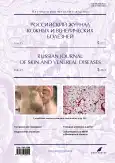Successful treatment of pyoderma gangrenosum in a patient winh ulcerative colitis and COVID-19 infection: case report
- 作者: Teplyuk N.P.1, Grabovskaya O.V.1, Kusraeva D.T.1, Grekova E.V.1, Koriakin D.A.1, Kostenko A.Y.1
-
隶属关系:
- I.M. Sechenov First Moscow State Medical University (Sechenov University)
- 期: 卷 25, 编号 5 (2022)
- 页面: 373-380
- 栏目: DERMATOLOGY
- URL: https://journals.rcsi.science/1560-9588/article/view/233229
- DOI: https://doi.org/10.17816/dv111864
- ID: 233229
如何引用文章
详细
Pyoderma gangrenosum is a rare inflammatory neutrophilic dermatosis, which causes ulceration of the skin. The condition is commonly associated with underlying systemic disorders such as inflammatory bowel disease, arthritis, and hematological disorders. Herein, we describe the case of a familiar association between pyoderma gangrenosum and ulcerative colitis complicated by the newly COVID-19 infection.
It is of particular clinical interest to address pyoderma gangrenosum lesions with concurrent treatment of associated disorders that may have influence on the course of the ulcer. Moreover, the therapy should cover as many diseases as possible while not being excessive to minimize possible side effects.
Thus, the selection of treatment that spans mutual pathophysiological features of all comorbidities represents the best option to make when handling pyoderma gangrenosum patients.
We present a case of the development of gangrenous pyoderma against the background of ulcerative colitis complicated by the new coronavirus infection COVID-19, which will raise awareness of gangrenous pyoderma as a relatively rare cause of ulcerative necrotic skin lesions, which can easily be confused with an infectious process.
Of particular clinical importance in the conditions of the COVID-19 pandemic is the correct treatment of gangrenous pyoderma. Only an integrated approach can give a positive result from the therapy.
作者简介
Nataliya Teplyuk
I.M. Sechenov First Moscow State Medical University (Sechenov University)
Email: Teplyukn@gmail.com
ORCID iD: 0000-0002-5800-4800
SPIN 代码: 8013-3256
MD, Dr. Sci. (Med.), Professor
俄罗斯联邦, MoscowOlga Grabovskaya
I.M. Sechenov First Moscow State Medical University (Sechenov University)
Email: olgadoctor2013@yandex.ru
ORCID iD: 0000-0002-5259-7481
SPIN 代码: 1843-1090
MD, Cand. Sci. (Med.), Associate Professor
俄罗斯联邦, MoscowDiana Kusraeva
I.M. Sechenov First Moscow State Medical University (Sechenov University)
编辑信件的主要联系方式.
Email: kysra1992@mail.ru
ORCID iD: 0000-0002-5633-7986
SPIN 代码: 1478-3503
Postgraduate Student
俄罗斯联邦, 4 build. 1, Bolshaya Pirogovskaya str., Moscow, 119991Ekaterina Grekova
I.M. Sechenov First Moscow State Medical University (Sechenov University)
Email: grekova_kate@mail.ru
ORCID iD: 0000-0002-7968-9829
SPIN 代码: 8028-5545
MD, Cand. Sci. (Med.)
俄罗斯联邦, MoscowDanila Koriakin
I.M. Sechenov First Moscow State Medical University (Sechenov University)
Email: danila110920021@gmail.com
ORCID iD: 0000-0003-3619-206X
Student
俄罗斯联邦, MoscowAnastasia Kostenko
I.M. Sechenov First Moscow State Medical University (Sechenov University)
Email: anastasiya.k9716@gmail.com
ORCID iD: 0000-0002-4115-540X
MD
俄罗斯联邦, Moscow参考
- Marzano AV, Damiani G, Ceccherini I, et al. Autoinflammation in pyoderma gangrenosum and its syndromic form (pyoderma gangrenosum, acne and suppurative hidradenitis). Br J Dermatol. 2017;176(6):1588–1598. doi: 10.1111/bjd.15226
- Alavi A, French LE, Davis MD, et al. Pyoderma gangrenosum: an update on pathophysiology, diagnosis and treatment. Am J Clin Dermatol. 2017;18(3):355–372. doi: 10.1007/s40257-017-0251-7
- Kridin K, Cohen AD, Amber KT. Underlying systemic diseases in pyoderma gangrenosum: a systematic review and meta-analysis. Am J Clin Dermatol. 2018;19(4):479–487. doi: 10.1007/s40257-018-0356-7
- Su WP, Davis MD, Weenig RH, et al. Pyoderma gangrenosum: clinicopathologic correlation and proposed diagnostic criteria. Int J Dermatol. 2004;43(11):790-800. doi: 10.1111/j.1365-4632.2004.02128.x
- Georgin-Lavialle S, Ducharme-Benard S, Sarrabay G, et al. Systemic autoinflammatory diseases: Clinical state of the art. Best Pract Res Clin Rheumatol. 2020;34(4):101529. doi: 10.1016/j.berh.2020.101529
- Barbosa NS, Tolkachjov SN, El-Azhary RA, et al. Clinical features, causes, treatments, and outcomes of peristomal pyoderma gangrenosum (PPG) in 44 patients: The Mayo Clinic experience, 1996 through 2013. J Am Acad Dermatol. 2016;75(5):931–939. doi: 10.1016/j.jaad.2016.05.044
- Ashchyan HJ, Butler DC, Nelson CA, et al. The association of age with clinical presentation and comorbidities of pyoderma gangrenosum. JAMA Dermatol. 2018;154(4):409–413. doi: 10.1001/jamadermatol.2017.5978
- Goodarzi H, Sivamani RK, Garcia MS, et al. Effective strategies for the management of pyoderma gangrenosum. Adv Wound Care (New Rochelle). 2012;1(5):194–199. doi: 10.1089/wound.2011.0339
- Teplyuk NP, Grabovskaya OV, Kusraeva DT, Varshavsky VA. Pyoderma gangrenosum: examination and treatment experience. Russian journal of skin and venereal diseases. 2022;25(1):61–72. (In Russ). doi: 10.17816/dv105685
- Olisova OY, Anpilogova EM. New coronavirus infection (COVID-19): a dermatologist’s view. Annals of the Russian academy of medical sciences. 2020;75(4):292–299. (In Russ). doi: 10.15690/vramn1359
- Genovese G, Moltrasio C, Berti E, Marzano AV. Skin manifestations associated with COVID-19: current knowledge and future perspectives. Dermatology. 2021;237(1):1–12. doi: 10.1159/000512932
- Borges L, Pithon-Curi TC, Curi R, Hatanaka E. COVID-19 and neutrophils: the relationship between hyperinflammation and neutrophil extracellular traps. Mediators Inflamm. 2020;2020:8829674. doi: 10.1155/2020/8829674
- Patel F, Fitzmaurice S, Duong C, et al. Effective strategies for the management of pyoderma gangrenosum: A comprehensive review. Acta Derm Venerol. 2015;95(5):525–531. doi: 10.2340/00015555-2008
- Soto Vilches F, Vera-Kellet C. Pyoderma gangrenosum: classic and emerging therapies. Medicina Clínica (English Edition). 2017;149(6):256–260. doi: 10.1016/j.medcle.2017.08.007
- Schwartz RA, Pradhan S, Murrell DF, et al. COVID-19 and immunosuppressive therapy in dermatology. Dermatologic Therapy. 2020;33(6):e14140. doi: 10.1111/dth.14140
- Tatiya-Aphiradee N, Chatuphonprasert W, Jarukamjorn K. Immune response and inflammatory pathway of ulcerative colitis. J Basic Clin Physiol Pharmacol. 2018;30(1):1–10. doi: 10.1515/jbcpp-2018-0036
- Syed K, Chaudhary H, Balu B. Pyoderma gangrenosum following COVID-19 infection. J Community Hosp Intern Med Perspect. 2021;11(5):601–603. doi: 10.1080/20009666.2021.1958492
- Kochar B, Herfarth N, Mamie C, et al. Tofacitinib for the treatment of pyoderma gangrenosum. Clin Gastroenterol Hepatol. 2019;17(5):991–993. doi: 10.1016/j.cgh.2018.10.047
- Fauny M, Moulin D, D’Amico F, et al. Paradoxical gastrointestinal effects of interleukin-17 blockers. Ann Rheum Dis. 2020;79(9):1132–1138. doi: 10.1136/annrheumdis-2020-217927
- Mikail M, Wilson A. Infliximab treatment for large, multifocal, abdominal pyoderma gangrenosum associated with ulcerative colitis: a case report. SAGE Open Med Case Rep. 2020;8:2050313X20964113. doi: 10.1177/2050313X20964113
- Kleinpenning MM, Langewouters AM, van De Kerkhof PC, Greebe RJ. Severe pyoderma gangrenosum unresponsive to etanercept and adalimumab. J Dermatolog Treat. 2011;22(5):261–265. doi: 10.3109/09546631003797106
- Guenova E, Teske A, Fehrenbacher B, et al. Interleukin 23 expression in pyoderma gangrenosum and targeted therapy with ustekinumab. Arch Dermatol. 2011;147(10):1203–1205. doi: 10.1001/archdermatol.2011.168
- Pichler M, Thuile T, Gatscher B, et al. Systematic review of surgical treatment of pyoderma gangrenosum with negative pressure wound therapy or skin grafting. J Eur Acad Dermatol Venereol. 2017;31(2):e61–e67. doi: 10.1111/jdv.13727
补充文件











